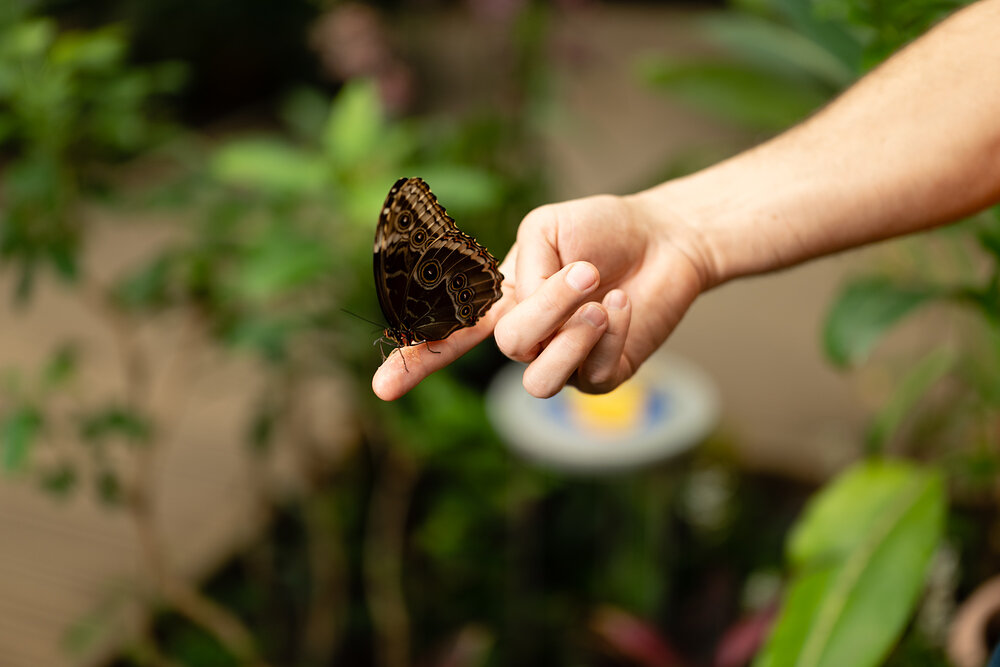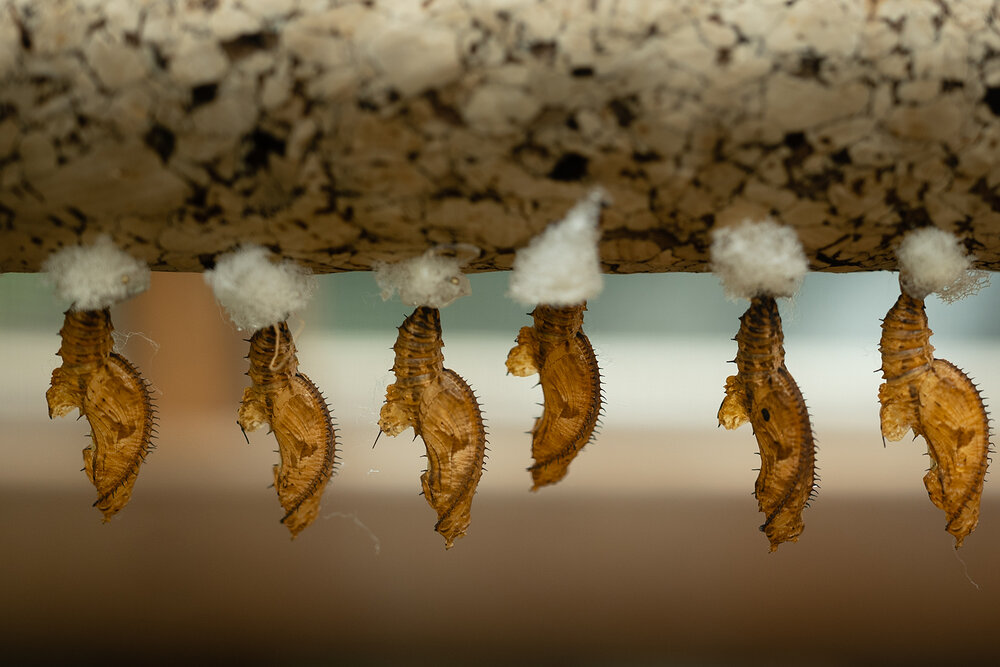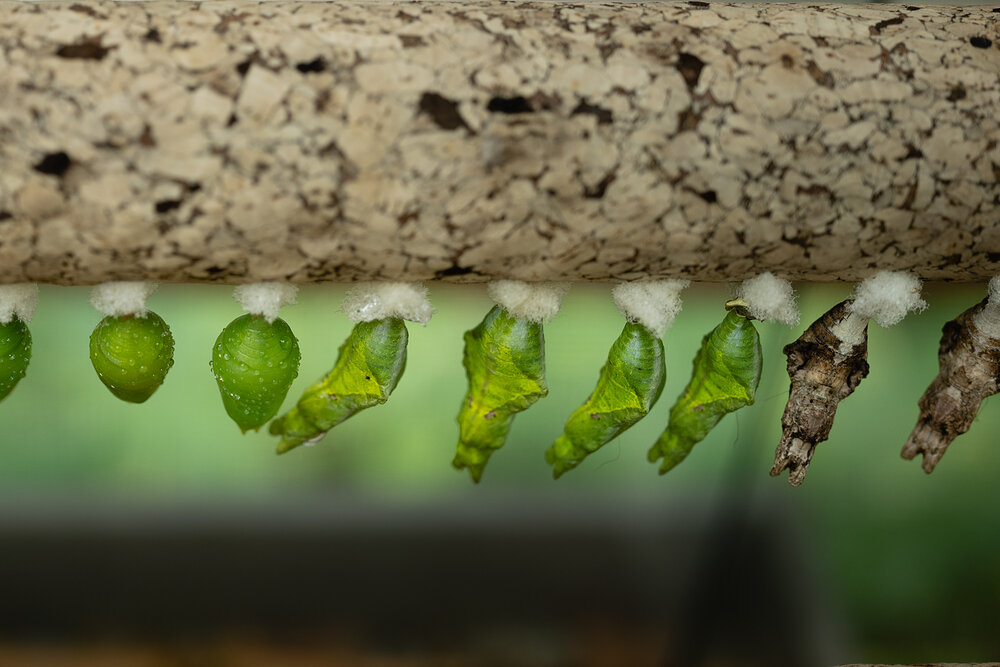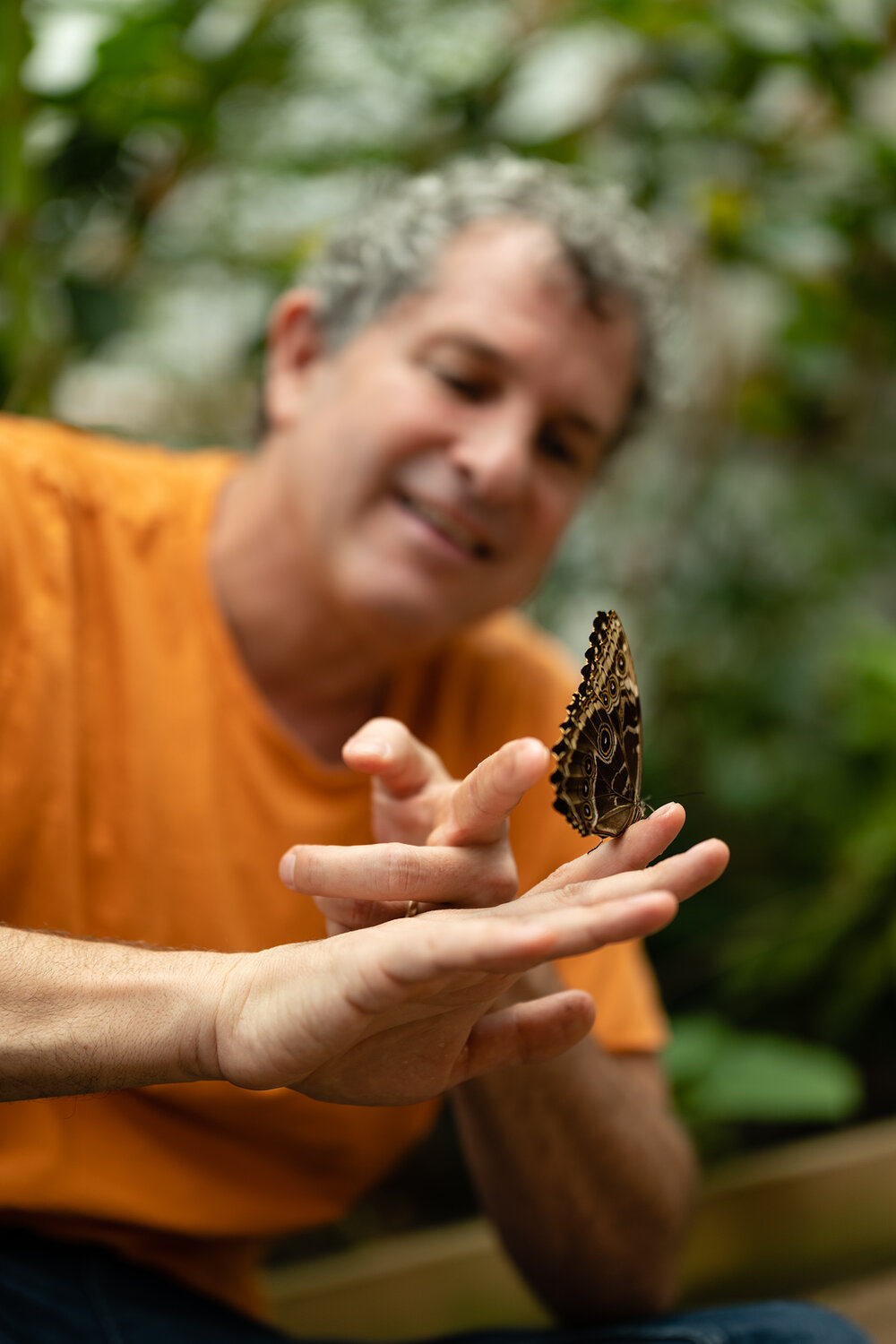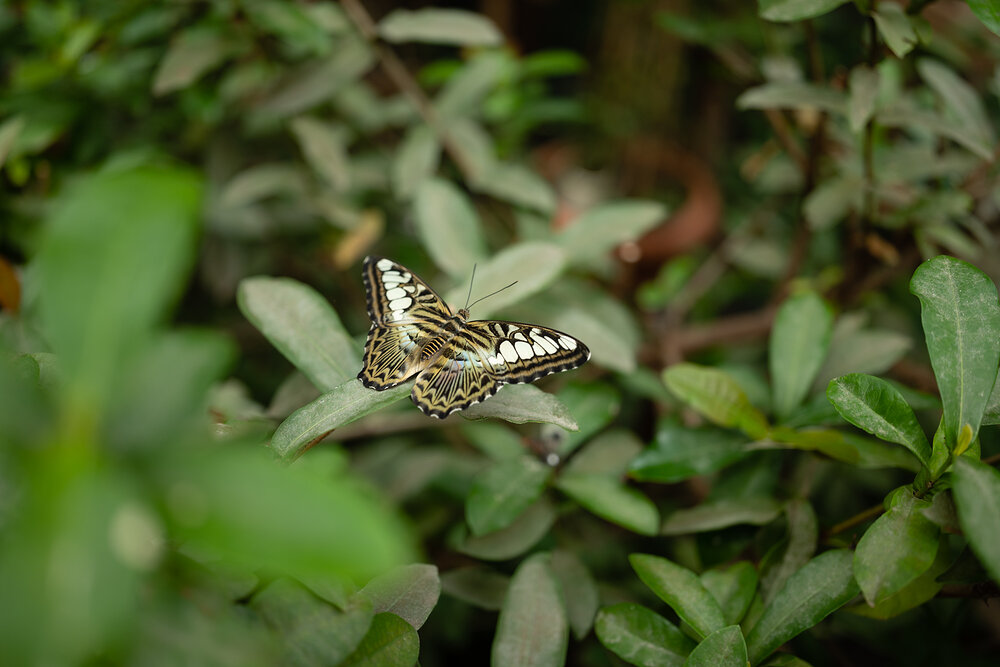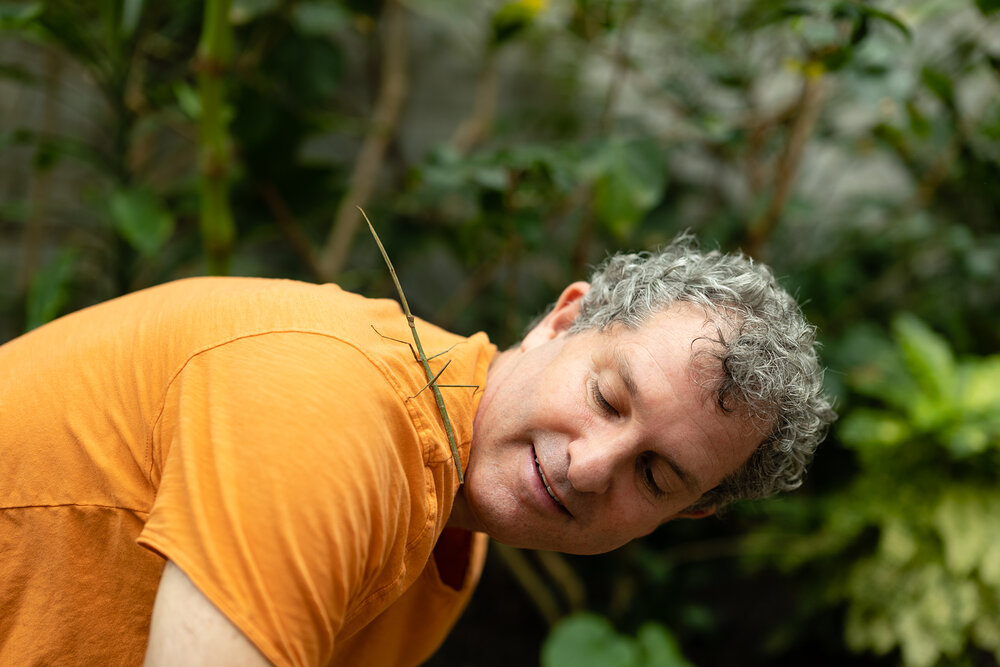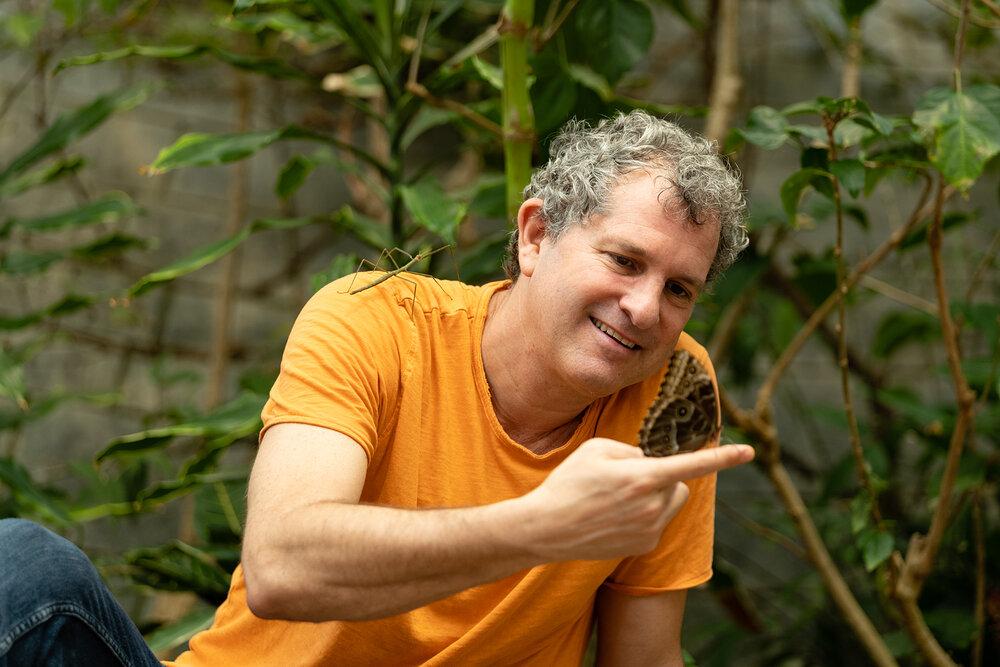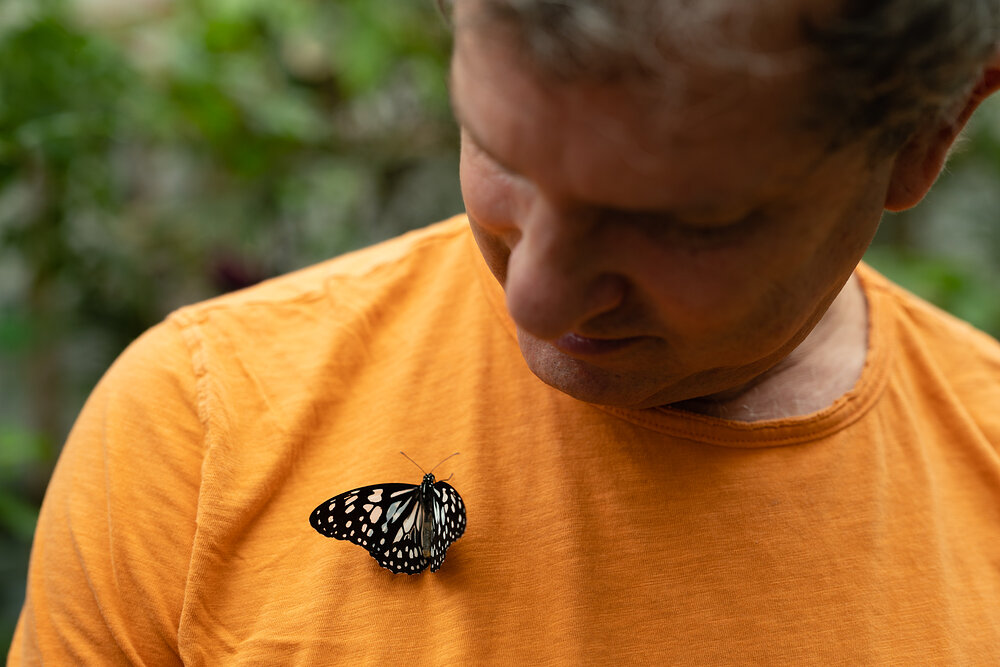Issue 18 / July 2023
On Butterflies and Truths
Lorraine Daston
Historians of science Lorraine Daston and Oren Harman on metamorphosis, altruism, and two different kinds of truth
Lorraine Daston: I would like to start with the question about whom you write for, because like many historians of science, you have had a zigzag career. You began by studying biology, you were a passionate collector of butterflies as a child, so a real naturalist in the old-fashioned sense. You almost went to medical school, but decided against it and then moved on to a PhD program at Oxford about rationality and ended up writing about a very important figure in the history of 20th century evolutionary theory and genetics, Cyril Darlington. With all that in mind, when you sit down to write, who are you writing for and whom do you think historians of science should write for – given that we all have this patchwork background and that we straddle the humanities, the social sciences, and the natural sciences?
Oren Harman: There is a selfish impulse to writing because writing is a journey of discovery. And the space between one’s fingertips and the keyboard is a place of magic where anything can happen anytime, like in ping pong or crazy love. So I think that any creation is first and foremost a matter of pleasure for the one who creates. And for me, the greatest pleasure is the pleasure of sound. Being a writer or a poet is another way of being a musician. For me, writing in a very real sense is like composing: I hear the next word or the next turn of phrase even before I consider its meaning. On the other hand, you can’t write without imagining a reader. And that reader has always been a curious, skeptical, open-faced fourteen-year-old.
LD: I should say a word about the background to this question, namely that we, the historians of science, have lost our audience of scientists. That is, we used to write not exclusively, but mostly for scientists, in part because many historians of science were scientists themselves or had had scientific backgrounds. That has changed radically in the past few decades.
OH: Right. Today many historians of science write exclusively for each other, which is too bad. But it’s also not entirely their fault. John Ruskin said, “You either make a tool of a creature or a man of him.” And minus the gender bias, I think he got it right. It’s a matter of how we view training. In my opinion, people should seek their education at the foundations of the “Tree of Knowledge,” study physics and biology and history and philosophy and the arts, and then acquire some important tools, which I would say are statistical thinking, languages, what used to be called rhetoric, and writing, or the ability to express oneself in words. It’s probably also a good idea to understand what code is nowadays. At a later stage, learn the history of your chosen field. But all that is not the same thing as teaching either fleeting technical skills or professional orientations that often cater to trends rather than actual thinking. When people clear their throats by saying, “as a sociologist” or “as a geochemist” or “as a historian of science,” I sort of cringe. We emphasize information, logic and technical knowledge and unfortunately also disciplinary fashions over and above creativity and wisdom. I think it was Niels Bohr who told some poor soul, “No, no, you’re not thinking, you’re just being logical.” Some languages, like mathematics, have evolved to be incredibly precise, and that’s great. But I don’t see why we need to guard the ramparts of many disciplines so religiously with jargon, nor shackle our mental independence to shifting winds. I have great respect for deep scholarship, and alongside the fourteen-year-old try to write simultaneously for my biggest professional critic. But often internal debates within sub-disciplines are somewhat less interesting to me than debates or ideas that invite a broader perspective. Historians of science should write for everyone.
LD: Let me follow up a bit on that. The amour-propre of historians of science has been wounded because we’ve lost a large part of our audience. But why should a scientist these days read the history of science? To be more specific, why, for example, should a practicing evolutionary biologist read your book on altruism?
OH: It’s important for ideas to know where they came from, to know how one problem led to another problem, and then created a third. It deepens one’s knowledge of one’s field, adds layers and shades and new textures of understanding. I also think that it’s important to show examples of how scientists and the rest of the world have dealt with the ethical and normative sides of discovery. History shouldn’t be and isn’t a replacement for ethics, but it can teach by example. I’d be happy if the history of science were part of the training of all scientists, but I’m aware that history doesn’t appeal equally to all scientists, and neither does ethics. The expectation that all scientists should become historians and think about the consequences of their work is wishful thinking. On the other hand, all scientists are humans. And for me, writing is also about trying to convey the feeling of ideas.
LD: Can you give a concrete example? Maybe from the altruism book?
OH: George Price was a quirky, brilliant American who boarded a boat to England in the late 1960s with the aim of solving a great scientific problem. Altruism in biology is defined as an action that reduces fitness for the actor, while providing a fitness benefit to another, and it exists throughout nature, from amoebas to ants to apes. But how could it have evolved if evolution is about survival of the fittest? Price came up with an equation, a deep treatment of the dynamics of selection, where selection is working at different levels simultaneously – on the gene, the individual, the group, maybe even the lineage. For a trait like altruism that makes a big difference, because if it’s working most strongly at the level of the group, altruism can evolve. All the great minds since Darwin had been trying to solve this problem. But Price was an outsider and practically produced his equation from thin air. This was just too much of a coincidence for a statistically-minded scientist. So he started thinking about other strange coincidences, such as that he’d had four girlfriends whose names were Anne, or that the last digits of his phone number signaled a moment before midnight. He multiplied the coincidences and came up with an unlikely number. There was only one thing to be done. This lonely, tortured rationalist ran out of his apartment into All Souls at Langham, fell down on his knees and became an evangelical Christian on the spot. He’d come to the realization that he had experienced a miracle, that God had chosen him: chosen him to tell the world where kindness comes from. Soon he began to think about the whole affair philosophically and came to believe that if you can formalize the evolution of a trait like altruism, this means that the trait is not what you think it is: scratch an altruist and watch an egoist bleed. Price responded by going out to the streets of London in order to prove that you could transcend the magical mathematics he had just brought to the world. Before long he’d become a radical altruist, putting up homeless people in his one-bedroom apartment and giving away his money, until he had nothing left. He himself became destitute and, living hand-to-mouth in a squat, ultimately committed suicide. But why did he kill himself? Reading his journal and letters and speaking to people who knew him, it became clear that at a certain point his rationalism must have kicked in again and that what bothered him most was his failure to distinguish between giving which is selfish as opposed to selfless. His conclusion was that science didn’t have the tools to expose an altruist. It was a terrible realization for someone who believed science is the best way to learn about the world, and even worse for a recently converted Christian. And so George Price killed himself. The possibility of genuine altruism became the key to understanding his tragic life. But it’s also fundamental to the science of altruism. So I tried to create a structure in the book that would allow Price’s personal anguish to resonate with the science, so that readers would have a felt experience of the scientific riddle over and above studying the equation.
LD: That’s a riveting and moving story. But as you know, historians of science have a prickly relationship with biography: When it’s really done well, it creates a vibration of sympathy between the reader and the subject of the biography. And if there’s one genre that scientists still like to read in the history of science, it is scientific biography. The reasons against the genre are most obviously – though certainly not in your case – that it tends toward hagiography, that it reduces the history of science to a kind of Mount Rushmore of great figures. But perhaps more deeply, that biography doesn’t do justice to science as a collective effort. Absolutely characteristic of science, at least since the 17th century and the advent of collective empiricism, is the fact that this is a group effort. Biography, by singling out and silhouetting the individual, somehow loses that quality of collective endeavor.
OH: I think that’s a valid point. But there’s a lot of variation within the sciences when it comes to large groups working together as opposed to the romantic version of individuals trying to crack a problem in their lab in the middle of the night. No one is an island, though George Price came pretty close. The Nature paper with the Price equation isn’t two pages long and has no references. Every scientist’s dream: to publish in Nature with no references. It was completely sui generis: it came out of his head.
LD: Don’t you pander to that ex nihilo dream of complete originality?
OH: Yes, a little bit for dramatic effect. And a biographer does have a responsibility to dig deep and wide to find the network of people that one is in contact with, that one is reading, that left a mark. And likewise to understand the technicalities and economics of the different tools and instruments that one is using and the institutional politics that form the backdrop of one’s days and nights. These are all important parts of the way science is produced, alongside the rhetoric that a scientist uses and the idiosyncratic ways in which he or she formulates and expresses ideas. No scientist stands alone, but good biographies show that while at the same time providing a window into a very particular soul. The mythographer Joseph Campbell has a wonderful quote. He said, “What we’re all searching for isn’t the meaning of life. Rather, what we’re searching for is a feeling of the rapture of being alive, so that our experiences on the purely physical level resonate somehow with an inner truth and inner reality.” That has been the distant horizon to which I look when I’m writing.
LD: Perhaps this is a natural transition to your project on metamorphosis here at the Wissenschaftskolleg. In conversations, I’ve been struck by how important it is to you to consider the body as well as the mind. And we’ve already mentioned that you absolutely break out in hives at both academic prose and a certain kind of officious academic specialization. Is the project on metamorphosis linked to that sense of discontent with the way in which academic work is done? Because it is all about, in some ways, the potential for change within this mortal coil?
OH: A nymph is seduced by a god, turned into a hunted bear, then a constellation. A boy consumed by self-love stares into a pool at his reflection, dying for not being able to part from himself, turning into a flower. People all over the world love reading Ovid because change is an inescapable part of life, full of terror and wonder. It’s a far greater subject than academic discontent. I began looking carefully at the existential side of change in my last book, Evolutions: Fifteen Myths That Explain Our World, which was an attempt to write the history of the universe and of life on Earth in myth-form, based on our latest cutting-edge science. This year at the Wissenschaftskolleg I have three projects that I’m trying to juggle. The first isn’t actually about metamorphosis. It’s a whodunit for seven- to twelve-year-olds, about the disappearance of Darwin’s notebooks from the Cambridge University Library and their mysterious reappearance twenty years later, gift-wrapped with a typed note, “Librarian, Happy Easter, X.” So the notebooks are back, but no one knows who stole them in the first place. I use that real-life hook to create a fictional story about three characters who go out to solve the crime. There’s Detective Doolittle, a somewhat slow Cambridgeshire policeman, there’s the world’s greatest Darwin specialist, the messy-haired Professor Winifred Wigglesworth, and there’s her adopted ape Erasmus, a clever and mischievous chimp about the age of my readers.
LD: After Charles Darwin’s grandfather...
OH: And brother. The motley crew go out on a whirlwind adventure in Cambridge to solve the crime. And here the writing challenge is to find that sweet spot between entertaining and teaching, because I’m hoping during this adventure that children will learn a lot about evolution without even noticing. The second project is a book for grown-ups that begins with an evolutionary mystery. Metamorphosis is energetically costly and puts organisms under a lot of stress. Just imagine a lobster trying to wiggle out of its carapace, or a caterpillar disbanding in a chrysalis.
LD: Like the peacock’s tail. An expensive luxury.
OH: And yet there are estimates that three quarters of all species on the planet undergo some form of metamorphosis. The question is, why? What problem is evolution trying to solve with a mechanism so Rube Goldbergesque? It turns out that many roads lead to Rome. And in that way it’s similar to the problem of altruism.
LD: Yes, there’s a certain structural affinity between these two problems.
OH: In altruism it’s about trying to explain the persistence of behavioral traits that reduce fitness if evolution is a game of survival of the fittest. In metamorphosis it’s about the birth of a life-cycle strategy that is incredibly expensive. But alongside the evolutionary issue, there’s a lot of really interesting basic science in endocrinology, developmental biology, physiology, genetics, even immunology that we have learned through the prism of trying to crack the problem of metamorphosis. That’s the scientific side. On the cultural side – from Ovid to Orwell, in music, painting and film and in the traditions of the world’s great religions, there is this preoccupation, almost obsession, with the themes emanating from metamorphosis: the hope of change, the tragedy of the life cycle, dramatic, often uninvited transformation.
LD: And also, of course, survival into the afterlife.
OH: Yes, that great puzzle too. And so I want to bring all of that richness to the page in this book, which is kind of impossible. It’s not a book of science, or of philosophy, and it’s not a history of science either. Rather, I’m writing it as a notebook of a father. And here, that balance of entertaining and teaching becomes crucial yet again in finding the structure or the device that might make it work.
LD: Before we get to the third project, I want to ask a question about, as I said, what seems to me a certain kind of narrative penchant for how you begin a project. In the whodunit, since we don’t know who the culprit was, you are at liberty to invent one. So in the children’s book you solve your mystery in a very satisfying way, I’m sure. But as far as I know, the mystery of metamorphosis has not yet been solved by biologists, that means you’re not going to be able to hand readers a solution in this multi-dimensional polyphonic book about metamorphosis. Have you thought about how you’re going to deal with the fact that you’re going to end – to return to music – not on a consonant chord, but a dissonant one?
OH: I’m still thinking! We’ve come a long way in understanding metamorphosis. Aristotle thought caterpillars come from dew, and Pliny the Elder that silk moths come from vapor on oak blossoms stripped off of trees by rain. For centuries, no one had any idea that tiny elvers in the ocean had anything to do with ferocious river eels, and butterflies remained mysterious to many 17th-century thinkers. But in the last one hundred years, we’ve figured out the role of hormones in metamorphosis and in the last thirty years we’ve begun to pick out the levers and push buttons at the genetic level that make all of this physiology work. We’ve even been able to use scanning technologies to peer into a chrysalis and see exactly how a butterfly is assembled. But there’s still a lot that we don’t know. And what remains particularly mysterious is the question of why in each instance has this evolved, and by what route. There are different theories, and not everyone agrees.
LD: Is it the case that there are multiple phylogenies for this?
OH: Well, there are multiple phylogenies, but then what happens on land is very different from what happens in the sea. In butterflies, a long period of growth as a caterpillar is followed by a fleeting life as a sexual adult, sometimes without mouthparts and only for a day. But a starfish larva has a very short life before it produces an adult that can live for decades on the sea floor. So there must be different explanations for why these things are happening.
LD: How broadly do you understand metamorphosis: is the embryo in the human womb another life-form than the adult form?
OH: Metamorphosis is defined biologically as radical post-embryonic development. That would mean everything that happens after the womb in the case of humans. But of course, you cannot understand that second side of things without understanding what first happens after a sperm enters an egg. You asked how am I going to write this book without there really being a solution. I’m trying to frame it within the pregnancy of my wife with our third child, Sol. The book will have three sections, like three trimesters of a pregnancy. The first section will be about ancient, medieval, and early modern approaches to metamorphosis, centered around the theme “where do we come from?”; the second about the advent of Darwinian thinking, centered around the question “where are we going?”, and the last about how we use genetics and imaging technologies to understand metamorphosis today. The question in this last section will be “what is the self?” But in all three sections there will be a return to the fundamental weirdness and mysteriousness and wonder of this phenomenon. At a philosophical level, there isn’t an attempt to try to answer that mystery, since there is no one answer. All of us are trying to figure out who we are. It’s a basic problem for anything that grows. Plutarch considered this when he wrote about the ship that brought Theseus back from Crete. The Athenians wanted to preserve it. But is it the same boat as it was if all the rotting planks are ultimately replaced? Who are we if we’re constantly changing? Each and every one of us will spend our lives searching. And some of us will find an answer, or different answers, during a lifetime.
LD: It’s interesting, because both the altruism problem and the metamorphosis problem spring from certain very fundamental assumptions about evolutionary biology. As Darwin realized from the very beginning, the altruism problem is: how is that kind of self-sacrifice compatible with reproductive fitness? And metamorphosis is apparently a colossal waste of energy, and risky to boot. Why go through these stages, each of which is quite precarious and leaves the organism open perhaps to all manner of dangers at the point of transition? The implicit assumption is that whatever the mechanism or the evolutionary explanation is, it is a functional explanation. So in that way, it’s also analogous to the problem of sexual selection, which was designed to explain another apparent squandering of resources and which is still controversial, I think, among evolutionary biologists. As Darwin’s critics were quick to point out, it leaves evolution in the hands of a very fickle female and her inexplicable whims. I wonder sometimes when you’re working on these problems, whether you don’t begin to see them as challenges to those fundamental assumptions.
OH: I was lucky enough to have Stephen J. Gould as a teacher and later to befriend Dick Lewontin, who was one of the smartest people who ever lived. Both were the authors of the metaphor of evolutionary spandrels, the notion that some of what we observe in nature is there for reasons other than maximizing fitness. In every case, you need to examine the adaptationist assumption under the microscope. I think evolutionary biologists have developed strong methods to help distinguish between traits that were selected for the fitness they confer and others that weren’t. Now, metamorphosis is so widespread in nature and has evolved a number of times that it beckons adaptationist explanations. What’s interesting about it is that while there are some underlying principles like reducing inter-generational conflict, decoupling growth from development, or predator avoidance, there are nonetheless different paths for different lineages and species. It’s not a one-size-fits-all solution, which makes it all the more important to look at ecological and developmental histories very carefully.
LD: I realize that the premise of the entire book is that metamorphosis is a broad enough concept to encompass not only all of these instances across many different taxa in biology, but also the metaphorical range that you described. And one conclusion that one might draw from what you just said is that this is not a monolithic phenomenon and that what we have been calling metamorphosis, in part because of this long heritage from Ovid on, is in fact a large and disparate category of different phenomena, each solving different adaptive problems.
OH: Yes, and there is of course something extremely arbitrary about the definition of biological metamorphosis. I mean, what does dramatic post-embryonic development mean? How dramatic does it have to be to be called metamorphosis? That returns to your question about whether humans metamorphose. Technically, humans aren’t considered metamorphic. We don’t undergo the dramatic transformation, for example, that a tadpole does when it turns into a frog or a toad.
LD: Not morphologically, but… your two-year-old daughter…
OH: …exactly. In this book I’d like to try to unsettle the accepted understanding of what metamorphosis is, to show that when it comes to change, we all exist on a continuum. Framing the story in a pregnancy will hopefully allow me to convey this through human feeling. One of the things that changes us the most in life is the people we lose along the way and the ones we bring to life. Both metamorphosis and birth mark beginnings, but are in fact continuations. Both, in different ways, are also forms of endings. And both make us wonder about the riddle of life.
LD: Well, I can’t wait to read the book.
OH: I can’t wait to write it!
LD: As we unfold the book in our conversation, it offers a very interesting example of how the history of science can not only engage both scientists and non-scientists, but also make a contribution to thinking about science. I think the best of the history and philosophy of biology in recent decades has been doing that. It has been an attempt to think really hard and clearly about concepts that are necessarily blurry when they’re first developed. This is not meant as a criticism. I mean this simply as a fact about the sheer difficulty of addressing these phenomena in nature, which are so dazzlingly diverse and hard to understand. It is very interesting to think about this by way of sharpening the focus on the idea of metamorphosis in ways that may either stretch it, for example by including human beings as metamorphic organisms, or may contract it in a kind of nominalist move in which we have lots of subcategories that we now think solve very different adaptive problems. Do you see that potential for it?
OH: Yes. This bring us back to your first question: should we write for scientists? I think that historians of science might be able to shine a light on a particular time in the history of science or a particular phenomenon or person that have been forgotten or haven’t been considered properly or with enough depth. Historians are also well placed to call attention to the contingent nature of human understanding. Then there’s some even more fundamental sense in which philosophers of science can do what you were just saying, which is to add levels of nuance that are an expansion or precision or even challenge to the concepts used by scientists. It’s my experience that good philosophers of biology can be more sophisticated than many scientists are about definitions and concepts used in workaday science. If we can find more ways to get scientists and humanists to really talk to each other, we’ll all be better for it.
LD: And it’s timing that is important. I’m thinking of the conversations among people like Elliott Sober and others about the problem of the meaning of the gene that had at least three definitions, all of which were in circulation. And increasingly, particularly with the work on EvoDevo, it became clear that the genome itself could not be described entirely in terms of inheritance, because there were changes going on regarding the methylation of the genome that were constantly turning genes on and off, like a kind of secondary perceptual system of the organism responding to its environment. At first all these attempts at conceptual clarification by the philosophers were staunchly resisted by the geneticists, who said, look, don’t confuse us, you can go back to your scholastic hair-splitting on your own time. But increasingly, as the research progressed, it became essential to have such distinctions. So there’s a need for stamina as well as clarity in those kinds of discussions.
OH: That’s right, and the gene is a good example because we all tend to think of it as a very real entity. And yet, from looking carefully at the history of science we learn that entities have a kind of pliable existence in time: they sometimes become more real and they sometimes begin to disband. You have written about it beautifully with regard to all kinds of wonders that people described in medieval and early modern times, like unicorns and dogs that speak French. The gene as we conceived it after Watson and Crick does work for us in that it’s helpful in solving particular problems. But that may change. Already, there are way too many exceptions to sustain the standard definition. I once wrote a piece called something like “Cherish Your Genes. They’ll Soon Be Gone.” The idea was to say that in fifty years from now, we might be able to measure the interactions between all functional proteins in the cell. And we might give that quantity a name, for example call it a “lene.” The lene will carry much more relevant information than the gene will, say for drug design, and as it gains a life of its own the gene might disappear entirely, or suddenly become a little less real.
LD: And it is interesting how very different the reactions of scientists are to these kinds of thought experiments. Some, as you say, are themselves pursuing them, Stephen J. Gould was a good example. But others feel queasy, for them, science is more than a day job. It is an all-consuming ethos, fueled by a bit of displaced religious sentiment. To be told that they’re not looking for eternal truths that will stand Gibraltar-firm for ages to come can be an unsettling thought. Have you encountered that?
OH: Of course, and I myself struggle with it. My colleague Naomi Oreskes wrote a book recently called Why Trust Science because she felt that we’re living in a time where it’s important to be able to convey to the public, which does not always trust scientists, why there are good reasons to believe in it nonetheless. The challenge to scientific truth has reached a point which is becoming dangerous. Constructivists believe science is just another human pursuit that doesn’t necessarily get us closer to any kind of Truth with a capital T. But truth with a small t is hard-earned.
LD: Isn’t there a third position between those two? Not necessarily deconstruction or a certain nihilism, but progress? I mean, isn’t the precondition for progress that the truths of today will have to change?
OH: When you think that the smartest people looking into the heavens for 1000 years believed that there had to be epicycles regularizing the movements of the heavenly bodies, and there was a whole mathematics that described exactly how those epicycles work…
LD: …which yielded predictions of planetary positions with astonishing accuracy.
OH: Yes. And then suddenly there are no epicycles. They’re gone. Or what about the great Aristotle, who believed that women have fewer teeth in their mouths than men do? It’s too simple-minded to say he was just wrong. It’s much more interesting and I think accurate to say, these are examples of the degree to which science is embedded in a particular culture in a particular time and place. To say that scientists think analogically and make use of metaphor, which is very sensitive to zeitgeist. And that while it produces a picture of reality which may for certain purposes be very accurate, it’s probably the case that with time we will come to describe these same phenomena in different ways. Just consider the brain: it was once a hydraulic system in miniature, ensconced in our skulls. Then it became a mechanical clock, then a telegraph switchboard, and then, into the twentieth century, a neural network. Some today think of it as a quantum computer. We often choose the latest technology to describe what we can’t really understand. And the metaphors create different entities – of which we can ask different questions and therefore also receive different answers.
LD: Interesting that one has to be almost apologetic in stating this, which I think every single historian would subscribe to: that science is embedded in its moment and its place. And when one thinks a bit further about it, if an idea is genuinely novel and allows us to see and understand things that people have not seen and understood before, then of course the resources of extant language are going to be inadequate to that. One must resort to metaphor to capture it. Both of the topics that you’ve worked on, altruism and metamorphosis, are like magnets for metaphor. In some ways, that’s what makes the kind of wide-ranging book you’re writing on metamorphosis possible. Do you think that there’s a particular role for singling out these metaphorically rich veins in the history of science?
OH: Yes, I think that altruism and metamorphosis are both deep, dramatic, and immediately recognizable examples which have a resonance in our own human lives and therefore become battlegrounds for precisely what we’re talking about: the struggle between a worldview which subscribes to Truth with a capital T versus a contextualized understanding that recognizes the limitations of human language and understanding. To warn about, but also to celebrate, the wonderful idiosyncrasies of the human species and of individual human beings. That’s the ticket.
LD: Maybe this is an area in which the historians and of course the scientists can be helpful to the philosophers: if we think that scientific truths are the best truths we have and yet they don’t conform to a philosophical notion of what truth is, then maybe we should rethink that notion of what truth is.
OH: Yes. That’s a very important lesson.
LD: Oren, let’s hear about the third project.
OH: The third project is also about metamorphosis, a picture book series for very young children, three- to five-year-olds – in other words, for my daughter Sol. I hope the series will have eight books; I’ve written three so far. Very short books, with a hero or heroine who is a metamorphosing creature. We have Alex the Axolotl, Benny the Butterfly, Stella the Sea Squirt, Simon the Starfish. And each one of them metamorphoses in nature in a very different way. For example, in starfish metamorphosis the egg produces a young larva, which looks like a tiny angel. It has wings, it flaps, it roams the open sea. Then one day from within its stomach, a second developmental program kicks in and begins to create the adult. These two creatures look nothing alike. One is translucent, the other colorful. One is miniscule, the other destined to be gigantic. Even their body symmetry is not the same, the first being bilateral and the other radial. But the adult grows in the stomach until it reaches a certain size, and in a moment filled with wonder, it detaches and, as the larva swims away, settles down on the sea floor as a starfish. What is the relation between these two creatures? Each and every one of their cells has the exact same genome, being put to use in different ways. One is not the father or the mother or a sibling of the other, they’re an identity. If you think of it in human terms, it’s like a child giving birth to its adult.
LD: Yes. It’s impossible not to be allegorical about this.
OH: And it’s not as if the adult is the future self of the child, because the child will always remain a child. And the child is not the past of the adult because the adult doesn’t have a past. So it brings up all these interesting philosophical questions about identity, and this will be the theme of this particular book on Simon the Starfish. Stella the Sea Squirt, on the other hand, is an entirely different drama. In sea squirt metamorphosis you have the creation of a larva, which resembles a swimming tadpole. At a certain point, when the light changes, it heads downwards, attaches itself to a rock or coral and begins to self-emulate. The tail shrivels, the nervous and digestive systems and body structure are completely broken down. And this being, which actually had a notochord like you and me, suddenly turns into a sea squirt. The only clue that it had ever been something completely different are teeth inside one of its siphons.
LD: …overturning our implicitly hierarchical notions about the direction of evolution, the direction in which things should go. They’re developing into invertebrates instead of vertebrates.
OH: Amazing, isn’t it? And that’s actually the theme of that little picture book: that going backwards isn’t necessarily a bad thing.
LD: Or is it backwards?
OH: Yes, exactly, thank you. That’s the philosophical question that I want to pose to young children. And let their wonderings linger, like a never-ending chocolate.
The pictures with Oren Harman have been taken in the Schmetterlingshaus der Biosphäre Potsdam. Many thanks to Marc Specht, Anastasia Kobler and Dietmar Griebner for their hospitality and help!
More on: Oren Harman
Images: © Maurice Weiss
